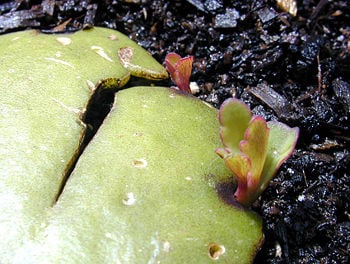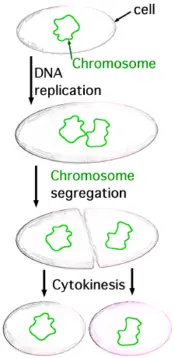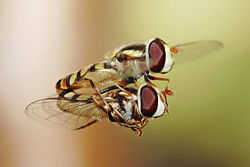Reproduction
In biology, reproduction is the process by which new individual organisms are produced. Reproduction is a fundamental feature of all known life; each individual organism exists as the result of reproduction. The known methods of reproduction are broadly grouped into two main types: Sexual reproduction and asexual reproductionl.
In asexual reproduction, an individual can reproduce without involvement with another individual of that species. The division of a bacterial cell into two daughter cells is an example of asexual reproduction. Asexual reproduction is not, however, limited to single-celled organisms. Most plants have the ability to reproduce asexually.
Sexual reproduction requires the involvement of two individuals, typically one of each sex. Normal human reproduction is a common example of sexual reproduction. In general, more-complex organisms reproduce sexually while simpler, usually unicellular, organisms reproduce asexually.
Asexual reproduction
Asexual reproduction is the biological process by which an organism creates a genetically-similar or identical copy of itself without a contribution of genetic material from another individual. Among groups of organisms that demonstrate asexual reproduction are bacteria, hydras, molds, annelid worms, yeast, mushrooms, algae, and plants.
Bacteria divide asexually via binary fission; viruses take control of host cells to produce more viruses; hydras (invertebrates of the order Hydroidea of the phylum Cnidaria) and yeasts are able to reproduce by budding. These organisms are capable of "splitting" themselves into two or more individuals. Other ways of asexual reproduction include fragmentation and spore formation that involves only mitosis.
In binary fission, there is a reproduction of a living cell by division into two equal or near-equal parts. It begins with DNA replication, with the DNA double strand separated and each strand serving as a template for synthesis of a daughter strand, until the entire prokayotic DNA is duplicated. Each DNA strand then attaches to the cell membrane and the cell elongates, causing the two chromosomes to separate. The cell membrane then invaginates (grows inwards) and splits the cell into 2 daughter cells, separated by a newly grown cell plate. This process is called cytokinesis. Baring complications, offspring would be genetically identical to the parent cell, but due to mutation and genetic recombination, daughter cells may have slightly differed genetic makeups. Bacterial DNA has a relatively high mutation rate. This rapid rate of genetic change is what makes bacteria capable of developing resistance to antibiotics and helps them exploit invasion into a wide range of environments. Organisms that reproduce through binary fission generally grow exponentially. E. coli cells are able to divide every 20 minutes under optimum conditions.
Among organisms that reproduce by binary fissions are the following:
- Bacteria (for example, Rickettsia species, which cause diseases such as Rocky Mountain spotted fever)
- Most protists (for example, Amoeba proteus)
- Entamoeba histolytica (a protozoan that is a human intestinal parasite)
- Pyrodictium abyssi (an anaerobic hyperthermophilic archaea of deep-sea hydrothermal vents)
- Schizosaccharomyces pombe (a fungal organism that is a species of yeast)
Budding is the formation of a new organism by the protrusion of part of another organism. This is very common in plants and fungi, but may be found in animal organisms, such as the hydra, as well. Usually, the protrusion stays attached to the primary organism for a while, before becoming free.
In fragmentation an organism is split into fragments. The splitting may or may not be intentional. Each of these fragments develop into mature, fully grown individuals that are a clone of the original organism. If the organism is split any further the process is repeated. Fragmentation is seen in many organisms such as molds, some annelid worms, and starfish. Binary fission may be considered a type of fragmentation involving single-celled organisms such bacteria, protozoa, and many algae. Molds, yeast, and mushrooms, all of which are part of the Fungi kingdom, produce tiny filaments called hyphae. These hyphae obtain food and nutrients from the body of other organisms to grow and fertilize. Then a piece of hyphae breaks off and grows into a new individual and the cycle continues.
Some 'asexual' species, like hydra and jellyfish, may also reproduce sexually. For instance, most plants are capable of vegetative reproduction—reproduction without seeds or spores—but can also reproduce sexually. Likewise, bacteria may exchange genetic information by conjugation.
Sexual reproduction
Sexual reproduction is a biological process by which organisms create descendants that have a combination of genetic material contributed from two (usually) different members of the species. Each of two parent organisms contributes half of the offspring's genetic makeup by creating haploid gametes. Most organisms form two different types of gametes. In these anisogamous species, the two sexes are referred to as male (producing sperm or microspores) and female (producing ova or megaspores). In isogamous species the gametes are similar or identical in form, but may have separable properties and then may be given other different names. For example, in the green alga, Chlamydomonas reinhardtii, there are so-called "plus" and "minus" gametes. A few types of organisms, such as ciliates, have more than two kinds of gametes.
Most animals (including humans) and plants reproduce sexually. Sexually reproducing organisms have two sets of genes for every trait (called alleles). Offspring inherit one allele for each trait from each parent, thereby ensuring that offspring have a combination of the parents' genes. Having two copies of every gene, only one of which is expressed, allows deleterious alleles to be masked, an advantage believed to have led to the evolutionary development of diploidy (Otto and Goldstein).
Allogamy
Allogamy is a term used in the field of biological reproduction describing the fertilization of an ovum from one individual with the spermatozoa of another. By contrast, autogamy is the term used for self-fertilization. In humans, the fertilisation event is an instance of allogamy. Self-fertilization (also known as autogamy) occurs in hermaphroditic organisms where the two gametes fused in fertilization come from the same individual. This is common in plants and certain protozoans. In plants, allogamy is used specifically to mean the use of pollen from one plant to fertilize the flower of another plant and usually syonymous with the term cross-fertilization or cross-pollination, though the latter term can be used more specifically to mean pollen exchange between different plant strains or even different plant species (where the term cross-hybridization can be used) rather than simply between different individuals. Parasites having complex life cycles can pass through alternate stages of allogamous and autogamous reproduction, and the description of a hitherto unknown allogamous stage can be a significant finding with implications for human disease.PMID 7100903
Mitosis and Meiosis
Mitosis and meiosis are an integral part of cell division. Mitosis occurs in somatic cells, while meiosis occurs in gametes.
Mitosis
The resultant number of cells in mitosis is twice the number of original cells. The number of chromosomes in the daughter cells is the same as that of the parent cell.
Meiosis
The resultant number of cells is four times the number of original cells. This results in cells with half the number of chromosomes present in the parent cell. A diploid cell duplicates itself, then undergoes two divisions (tetroid to diploid to haploid), in the process forming four haploid cells. This process occurs in two phases, meiosis I and meiosis II.
Reproductive strategies
There is a wide range of reproductive strategies employed by different species. Some animals, such as the human and Northern Gannet, do not reach sexual maturity for many years after birth and even then produce few offspring. Others reproduce quickly; but, under normal circumstances, most offspring do not survive to adulthood. For example, a rabbit (mature after 8 months) can produce 10–30 offspring per year, and a fruit fly (mature after 10–14 days) can produce up to 900 offspring per year. These two main strategies are known as K-selection (few offspring) and r-selection (many offspring). Which strategy is favoured by evolution depends on a variety of circumstances. Animals with few offspring can devote more resources to the nurturing and protection of each individual offspring, thus reducing the need for a large number of offspring. On the other hand, animals with many offspring may devote less resources to each individual offspring; for these types of animals it is common for a large number of offspring to die soon after birth, but normally enough individuals survive to maintain the population.
Other types of reproductive strategies
Polycyclic animals reproduce intermittently throughout their lives.
Semelparous organisms reproduce only once in their lifetime, such as annual plants. Often, they die shortly after reproduction. This is a characteristic of r-strategists.
Iteroparous organisms produce offspring in successive (e.g. annual or seasonal) cycles, such as perennial plants. Iteroparous animals survive over multiple seasons (or periodic condition changes).
Asexual vs. sexual reproduction
Organisms that reproduce through asexual reproduction tend to grow in number exponentially. However, because they rely on mutation for variations in their DNA, all members of the species have similar vulnerabilities. Organisms that reproduce sexually yield a smaller amount of offspring, but the large amount of variation in their genes makes them less susceptible to disease.
Many organisms can reproduce sexually as well as asexually. Aphids, slime molds, sea anemones, some species of starfish (by fragmentation), and many plants are examples. When environmental factors are favorable, asexual reproduction is employed to exploit suitable conditions for survival such as an abundant food supply, adequate shelter, favorable climate, disease, optimum pH or a proper mix of other lifestyle requirements. Populations of these organisms increase exponentially via asexual reproductive strategies to take full advantage of the rich supply resources.
When food sources have been depleted, the climate becomes hostile, or individual survival is jeopardized by some other adverse change in living conditions, these organisms switch to sexual forms of reproduction. Sexual reproduction ensures a mixing of the gene pool of the species. The variations found in offspring of sexual reproduction allow some individuals to be better suited for survival and provide a mechanism for selective adaptation to occur. In addition, sexual reproduction usually results in the formation of a life stage that is able to endure the conditions that threaten the offspring of an asexual parent. Thus, seeds, spores, eggs, pupae, cysts or other "over-wintering" stages of sexual reproduction ensure the survival during unfavorable times and the organism can "wait out" adverse situations until a swing back to suitability occurs.
Life without reproduction
The existence of life without reproduction is the subject of some speculation. The biological study of how the origin of life led from non-reproducing elements to reproducing organisms is called abiogenesis. Whether or not there were several independent abiogenetic events, biologists believe that the last common ancestor to all present life on earth lived about 3.5 billion years ago.
Today, some scientists have speculated about the possibility of creating life non-reproductively in the laboratory. One group of scientists has succeeded in producing a simple virus from entirely non-living materials. The production of a truly living organism, such as a simple bacterium, with no ancestors would be a much more complex task, but may well be possible according to current understanding of biology.
The virus is often regarded as not alive. Being nothing more than a bit of RNA or DNA in a protein capsule, they have no metabolism and can only replicate with the assistance of a hijacked cell's metabolic machinery.
Lottery principle
The lottery principle is the term for a theory about why sexual reproduction is so widespread, introduced in 1975 by George C. Williams, a biology professor at Princeton University.
Sexual reproduction has many drawbacks, since it requires far more energy than asexual reproduction, and there is some argument about why so many species use it.
William used lottery tickets as an analogy for his theory. He argued that asexual reproduction, which produces little or no genetic variety in offspring, was like buying a large number of tickets that all have the same number, limiting the chance of "winning" - that is, surviving. Sexual reproduction, he argued, was like purchasing fewer tickets but with a greater variety of numbers and therefore a greater chance of success.
The point of this analogy is that since asexual reproduction does not produce genetic variations, there is little ability to quickly adapt to a changing environment. The lottery principle is less accepted these days because of evidence that asexual reproduction is more prevalent in unstable environments, the opposite of what it predicts.
See also
- Self-pollination
- Self-replication — other forms of self-replication, including mechanical self-replication.
- Parthenogenesis — (from the Greek παρθενος, "virgin", + γενεσις, "birth") means the growth and development of an embryo or seed without fertilization by a male.
- Allogamy — the fertilization of an ovum from one individual with the spermatazoa of another.
ReferencesISBN links support NWE through referral fees
- S. P. Otto and D. B. Goldstein. "Recombination and the Evolution of Diploidy". Genetics. Vol 131 (1992): 745-751.
- Tobler, M. & Schlupp ,I. (2005) Parasites in sexual and asexual mollies (Poecilia, Poeciliidae, Teleostei): a case for the Red Queen? Biol. Lett. 1 (2): 166-168.
- Zimmer, Carl. "Parasite Rex: Inside the Bizarre World of Nature's Most Dangerous Creatures", New York: Touchstone, 2001.
- "allogamy, cross-fertilization, cross-pollination, hybridization". GardenWeb Glossary of Botanical Terms (2.1). (2002).
- "allogamy". Stedman's Online Medical Dictionary (27). (2004).
External links
- Asexual Reproduction
- Human reproductive system webpage
- Journal of Biology of Reproduction
- Journal of Andrology
Credits
New World Encyclopedia writers and editors rewrote and completed the Wikipedia article in accordance with New World Encyclopedia standards. This article abides by terms of the Creative Commons CC-by-sa 3.0 License (CC-by-sa), which may be used and disseminated with proper attribution. Credit is due under the terms of this license that can reference both the New World Encyclopedia contributors and the selfless volunteer contributors of the Wikimedia Foundation. To cite this article click here for a list of acceptable citing formats.The history of earlier contributions by wikipedians is accessible to researchers here:
- Biological_reproduction history
- Binary_fission history
- Fragmentation_(biology) history
- Budding history
The history of this article since it was imported to New World Encyclopedia:
Note: Some restrictions may apply to use of individual images which are separately licensed.


